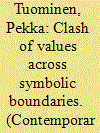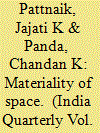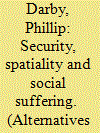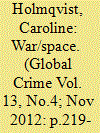|
|
|
Sort Order |
|
|
|
Items / Page
|
|
|
|
|
|
|
| Srl | Item |
| 1 |
ID:
119172


|
|
|
| 2 |
ID:
192938


|
|
|
|
|
| Summary/Abstract |
The materiality of space refers to the material constituents determining the space. The spatial imagination of the borderland, characterised by critical spatiality, is materially constituted. The fact of being materially constituted means to be infrastructurally configured. The infrastructures here include hydro projects, highways, railroads, bridges, tunnels, airports, digital connectivity and other defence-related installations. These projects combine a two-pronged approach: security and development. The security challenges that the border space embodies compel the state to adopt an approach of competitive infrastructure building. The nature of this competition is determined by the competing other’s approach towards the border space. Arunachal Pradesh is a very critical border state that shares its crucial border space of 1,080 km with China, 160 km with Bhutan and 440 km with Myanmar. China’s increasing geopolitical clout in the region intensifies its spatial and material prominence. India under its Act East Policy (AEP) formulation in 2014 has taken up a very determined approach to accelerating infrastructure growth in the northeast and more particularly in Arunachal Pradesh for its border spatiality. Therefore, the border space loses its inferential, conjectural and abstract character and becomes materially determined. This imperative for materiality embodies, on the one hand, development, modernity, capitalist social space and mainstreaming of the neglected and, on the other hand, protectionism and upgradation of security architecture along critical geography known as the border space. Therefore, this study examines the development of materiality, meaning infrastructure, in a complex border space like Arunachal Pradesh. It decodes the economic logic of the systematic development of border space by the Indian nation-state from the point of view of the growth of the region and security urgency. It uses Henri Lefebvre’s theoretical formulations of spatiality to understand the convoluted category of border space and the introduction of material forces to achieve security and developmental objectives.
|
|
|
|
|
|
|
|
|
|
|
|
|
|
|
|
| 3 |
ID:
075772


|
|
|
| 4 |
ID:
116126


|
|
|
|
|
| Publication |
2012.
|
| Summary/Abstract |
Understandings of war - its shape, form, character and content - are conditioned by conceptualisations and narratives of social and political space. As such, the history of writing on war is also a history of spatiality, expressed through a particular circumstance and practice. Through analysis of early modern conceptualisations of space, politics and war, this article considers the shift in political spatiality associated with the demise of modern linear spatiality that firmly established the territorial state as site of politics and war. The central argument of this article is that contemporary accounts of war reveal a political spatiality in flux coupled with an insistence on the global, such that many accounts of war neglect its political content. Three key accounts of contemporary war are engaged: liberal discourses of war as 'policing'; accounts of war as 'biopolitical empire'; and discourses of war as 'risk management' - all found, in different ways and collectively, to disregard the political confrontation that war necessarily entails.
|
|
|
|
|
|
|
|
|
|
|
|
|
|
|
|
| 5 |
ID:
079931


|
|
|
|
|
| Publication |
2007.
|
| Summary/Abstract |
This article offers a critical re-examination of the concept of world order. Taking our cue from Georg Sørensen's recent article in this journal entitled `What Kind of World Order?' we begin by unpacking the concept of order itself. We distinguish two principal meanings of the term: one analytical and descriptive (order as non-randomness) and one value-laden and normative (order as stability and the absence of violent conflict). In debates about world order, these two meanings are often blurred. Drawing on William Connolly's critique of the descriptive-normative distinction, we suggest that this blurring occurs in part because world order is an `essentially contested concept'. Practices of ordering typically involve the production of specific spatializations, yet questions of space and spatiality are largely absent from discussions of world order. In the second part of the article, therefore, we address this absence through a discussion of geo-politics, focusing on US hegemony and neo-liberalism, military geographies and the spaces of marginalization and resistance. The article concludes with some reflections on the political implications of a spatialized account of world order
|
|
|
|
|
|
|
|
|
|
|
|
|
|
|
|
|
|
|
|
|